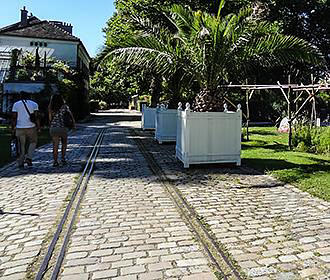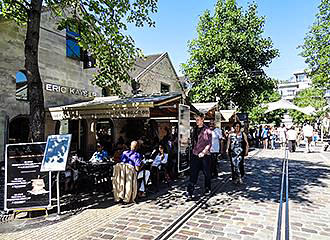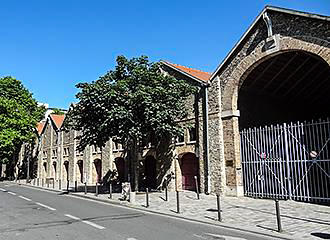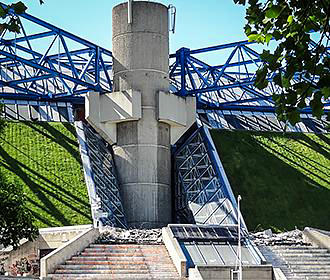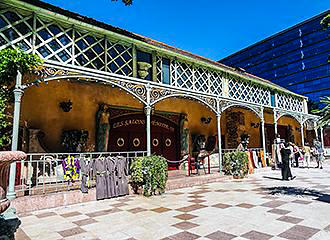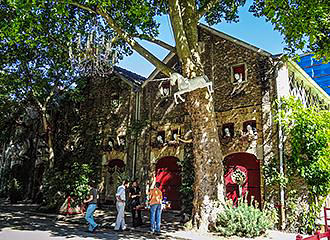Paris Bercy History started back in the 12th century
Bercy is an area in Paris that became the largest wine market worldwide and also became home to fairgrounds and other entertainment, yet has been completely revamped over the years with some buildings having now been preserved, and Paris has seen the re-birth of an entire district.
And incredibly, when much of the area was being completely reorganised, the rich Paris Bercy history was to reveal itself in 1991, as there were ancient pirogues, which are generally like flat bottomed dug out canoes found, along with an arc made of yew that has been dated back to the 5th millennium BC, which means it is one of the oldest ever found.
The beginnings of the Paris Bercy history
The Paris Bercy area was originally marshland and at the time of the Gauls and the Romans the area was not inhabited and it would be far later when the marshes were drained.
Now according to legend, the name Bercy comes from the island located in the estuary of the River Seine that was called Belsinaca, which is where Celtic tribes had once constructed huts in around the year 850.
Yet Paris Bercy history truly started back in the 12th century when the name of Bercy became official, when King Louis VI gave a donation to the Montmartre Abbey, which is where the convent was set up and the Eglise Saint-Pierre de Montmartre church was constructed on top of Montmartre hill.
However, it was only in 1415 that the first seigneury was established, which is where parts of land are granted by the King to certain people, and this area was owned by the Montmorency and towards the end of the century by the Malon family.
And during the end of the 1600s, the Lord of Bercy, Charles Henry de Malon asked for a castle to be built, and the gardens were designed by Le Notre.
The next stage of Paris Bercy history
As the Paris Bercy history rolled on by, the next notable point in time was in the year 1704 when King Louis XIV was attending a service at the Notre Dame de Bercy and subjects were meant to kneel before the king, but according to reports, there was one man that remained standing.
Classed as a crime against the king, a guard was sent to put a stop to this, but the king was actually amused by the large gentleman, who was a wine grower, and he took advantage of the situation and complained to King Louis XIV about the hassle he had with his business.
The king then decided to grant him a bit of leeway and ensured that the gentleman could sell his wine completely free of taxes, but only in the area of Bercy, and hence the first wine cellar of Bercy was born.
Paris Bercy history until the late 1900s
The next grand point in the Paris Bercy history was when The municipality of Bercy was first constituted in 1790, which was following the creations of different municipalities by the National assembly, yet it was not until January 1860 that Bercy was fully integrated into Paris.
And gradually over time, especially after the French Revolution, the number of wine cellars was increasing dramatically and eventually it becomes the largest wine market worldwide.
So, on an area of around 43 hectares where traffic was limited and only accessible to wine merchants and their clients, bar a train track that used to also travel through the area, there were numerous wine bars along with guinguettes, which were basically open air Paris cafes.
It became the place for people to go and enjoy not only the wine but the festivities such as fairground attractions and fireworks that were frequent in Bercy, not forgetting the people that used to enjoy rowing on the River Seine, which is located virtually next to this area.
However, there have been many catastrophes that have plagued the Bercy area of Paris over the years including major fires and also major flooding, especially in 1910 when the River Seine overflowed and the whole of Bercy became like a lake village for a while.
Yet Paris Bercy history went on, but the area became more and more abandoned and most of the wine cellars were demolished, and the Pavillons de Bercy remain some of the last examples of the architecture remaining from this period, but during the 1970s a plan was put in place to redevelop this part of Paris.
Paris Bercy history from 1979 to present
Now this part of the Paris Bercy history was to change everything, as it was in 1979 that the city of Paris first launched the start of the redevelopment of the Bercy area with the construction of the Palais Omnisports de Paris-Bercy, which is a sports and concert stadium called the POPB for short, although this has since changed its name to AccorHotels Arena.
There was also a large area designated for a park in Paris aptly named the Parc de Bercy that includes a kitchen garden and rose garden, similar to those that were originally there in the 19th century. But there are also modern flats that were designed by Christian de Portzamparc on one side of the park, who also designed the Cite de la Musique in the Parc de la Villette.
Another area is known as the Coeur Saint Emilion, but this is also often known as Bercy Village, and urban planners integrated shopping, leisure, culture, restaurants and cafes, just like Covent Garden in London, which is spread over an area of around 23,000 square metres that was opened in 2000, and it also included wine cellars that had been renovated.
So, as you can tell, this is one area of Paris that has something for everyone, whether it be eating out, the shopping and boutiques, the wine cellars, maybe visiting the fairground museum within the Pavillons de Bercy, which is called the Musee des Arts Forains or perhaps attending a live sporting event or concert at the POPB stadium, AccorHotels Arena.
And as the Paris Bercy history continues to evolve, its future prospects remain bright, with ongoing development projects and investments promise to further enhance the district's appeal. But today, it stands as a testament to the power of visionary planning and community engagement, a vibrant district that honours its past while embracing the future.
